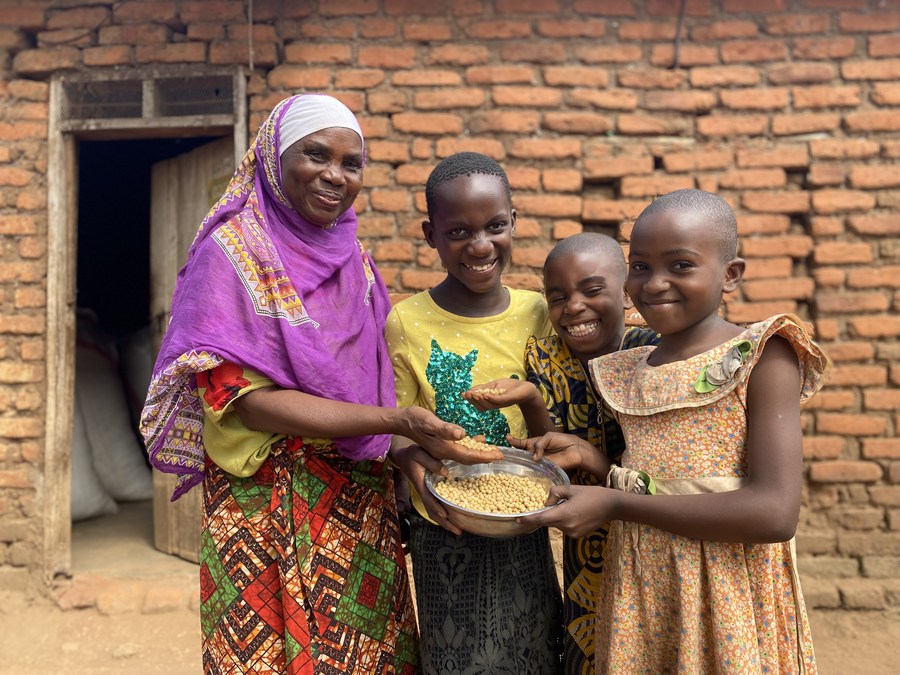Belt and Road Initiative brings prosperity to Africa
Belt and Road Initiative brings prosperity to Africa China Daily


African Countries and the Belt and Road Initiative
Tanzanian farmers show soybeans produced with technology developed by the China Agricultural University (CAU) in collaboration with Morogoro regional authorities in Morogoro, Tanzania, Aug 5, 2023. [Photo/Xinhua]

African countries and other developing countries should continue being proactive in seizing the unfolding opportunities, offered by China’s cooperation platforms and institutional frameworks, to accelerate the process of attaining higher levels of prosperity.
The Belt and Road Initiative
On Sept 7, 2013, President Xi Jinping announced that China and Central Asian countries would build a Silk Road Economic Belt to promote connectivity and strengthen people-to-people exchanges, when he delivered a speech at Nazarbayev University in Kazakhstan. One month later, while addressing the Indonesian parliament, Xi made a further proposal that China is ready to work with ASEAN countries in building the 21st Century Maritime Silk Road to promote cooperation.
The Silk Road Economic Belt and the 21st Century Maritime Silk Road later came to be known as the Belt and Road Initiative. This year marks the 10th anniversary of the initiative.
The Belt and Road Initiative and Africa
The initiative is a framework not only for consolidating and complementing existing China-Africa relations but also for addressing Africa’s socio-economic challenges more comprehensively, given its rich menu of objectives ranging from connectivity promotion, industrialization, development of agriculture and financing to enhancing inter- and intra-trade.
Taking into consideration the challenges emerging during Africa’s development and the urgent need to address them, the initiative is indeed a timely wake-up call for Africa to grasp the unfolding, rare, and unprecedented opportunity in the socio-economic development process.
Characteristics of the Belt and Road Initiative
- Compactness and wide synergic effects. In other words, it is holistic and each of its objectives contributes to the attainment of two or more of the others.
- Promoting connectivity by the provision of the requisite infrastructure will not only enhance and upgrade regional and global trade but also improve the investment climate within the partner countries.
- The improved investment climate would in turn lure foreign direct investment (FDI) back, which is critical for industrialization.
- Ultimately, it leads to sustainable transformation in terms of poverty reduction, environmental sustainability, and inclusive social development.
This virtuous cycle of achievements of the BRI unmistakably highlights the initiative’s exceptional nature.
Under such circumstances, the initiative is believed highly compatible with Africa’s socio-economic aspirations as stipulated in continental, regional, and individual countries’ blueprints.
Benefits of the Belt and Road Initiative
Experience within Africa and beyond has demonstrated that those who have already embraced the initiative have reaped substantial benefits.
- Since joining the Belt and Road cooperation in 2018, Tanzania has maintained steady economic growth with Chinese investments playing an important role.
- The level of industrialization has risen accordingly as 60 percent of Chinese investments are in the manufacturing sector.
- More jobs have been created, which has improved employment greatly, and the poverty rate has been declining year by year.
- Human development capacity has been enhanced through the provision of health services, education facilities, and scholarships.
Meanwhile, the BRI creates adequate space for the voice of the cooperating partners to be heard.
African countries and other developing countries should continue being proactive in seizing the unfolding opportunities, offered by China’s cooperation platforms and institutional frameworks, to accelerate the process of attaining higher levels of prosperity.
Editor’s note: Humphrey P. B. Moshi is a professor of economics and director of the Center for Chinese Studies at the University of Dar es Salaam of Tanzania.
The views expressed in this article are those of the author and do not necessarily reflect the positions of Xinhua News Agency.
SDGs, Targets, and Indicators
-
SDG 1: No Poverty
- Target 1.1: By 2030, eradicate extreme poverty for all people everywhere
- Indicator: Poverty rate and number of people living in extreme poverty
-
SDG 2: Zero Hunger
- Target 2.3: By 2030, double the agricultural productivity and incomes of small-scale food producers
- Indicator: Agricultural productivity and income levels of small-scale food producers
-
SDG 8: Decent Work and Economic Growth
- Target 8.1: Sustain per capita economic growth in accordance with national circumstances and, in particular, at least 7 percent gross domestic product growth per annum in the least developed countries
- Indicator: Gross domestic product (GDP) growth rate
-
SDG 9: Industry, Innovation, and Infrastructure
- Target 9.1: Develop quality, reliable, sustainable, and resilient infrastructure, including regional and transborder infrastructure, to support economic development and human well-being, with a focus on affordable and equitable access for all
- Indicator: Proportion of the population with access to affordable and reliable infrastructure services
-
SDG 10: Reduced Inequalities
- Target 10.1: By 2030, progressively achieve and sustain income growth of the bottom 40 percent of the population at a rate higher than the national average
- Indicator: Income growth rate of the bottom 40 percent of the population
-
SDG 17: Partnerships for the Goals
- Target 17.6: Enhance North-South, South-South, and triangular regional and international cooperation on and access to science, technology, and innovation and enhance knowledge sharing on mutually agreed terms, including through improved coordination among existing mechanisms
- Indicator: Proportion of total government spending on essential services (education, healthcare, social protection) as a percentage of total expenditure
Table: SDGs, Targets, and Indicators
| SDGs | Targets | Indicators |
|---|---|---|
| SDG 1: No Poverty | Target 1.1: By 2030, eradicate extreme poverty for all people everywhere | Poverty rate and number of people living in extreme poverty |
| SDG 2: Zero Hunger | Target 2.3: By 2030, double the agricultural productivity and incomes of small-scale food producers | Agricultural productivity and income levels of small-scale food producers |
| SDG 8: Decent Work and Economic Growth | Target 8.1: Sustain per capita economic growth in accordance with national circumstances and, in particular, at least 7 percent gross domestic product growth per annum in the least developed countries | Gross domestic product (GDP) growth rate |
| SDG 9: Industry, Innovation, and Infrastructure | Target 9.1: Develop quality, reliable, sustainable, and resilient infrastructure, including regional and transborder infrastructure, to support economic development and human well-being, with a focus on affordable and equitable access for all | Proportion of the population with access to affordable and reliable infrastructure services |
| SDG 10: Reduced Inequalities | Target 10.1: By 2030, progressively achieve and sustain income growth of the bottom 40 percent of the population at a rate higher than the national average | Income growth rate of the bottom 40 percent of the population |
| SDG 17: Partnerships for the Goals | Target 17.6: Enhance North-South, South-South, and triangular regional and international cooperation on and access to science, technology, and innovation and enhance knowledge sharing on mutually agreed terms, including through improved coordination among existing mechanisms | Proportion of total government spending on essential services (education, healthcare, social protection) as a percentage of total expenditure |
Analysis
The article discusses the Belt and Road Initiative (BRI) and its impact on African countries’ socio-economic development. Based on the content, the following SDGs, targets, and indicators can be identified:
1. SDG 1: No Poverty
The article highlights that the BRI has led to steady economic growth in Tanzania, creating more jobs and reducing the poverty rate. This aligns with SDG 1’s target to eradicate extreme poverty for all people everywhere.
2. SDG 2: Zero Hunger
The BRI’s impact on Tanzania’s agricultural sector, as mentioned in the article, has led to increased agricultural productivity and incomes for small-scale food producers. This relates to SDG 2’s target to double the agricultural productivity and incomes of small-scale food producers.
3. SDG 8: Decent Work and Economic Growth
The article states that Chinese investments in Tanzania have played a significant role in maintaining steady economic growth and increasing industrialization. This aligns with SDG 8’s target to sustain per capita economic growth, particularly in least developed countries.
4. SDG 9: Industry, Innovation, and Infrastructure
The BRI’s focus on infrastructure development, as mentioned in the article, contributes to SDG 9’s target of developing quality, reliable, sustainable, and resilient infrastructure to support economic development
Behold! This splendid article springs forth from the wellspring of knowledge, shaped by a wondrous proprietary AI technology that delved into a vast ocean of data, illuminating the path towards the Sustainable Development Goals. Remember that all rights are reserved by SDG Investors LLC, empowering us to champion progress together.
Source: chinadaily.com.cn

Join us, as fellow seekers of change, on a transformative journey at https://sdgtalks.ai/welcome, where you can become a member and actively contribute to shaping a brighter future.







